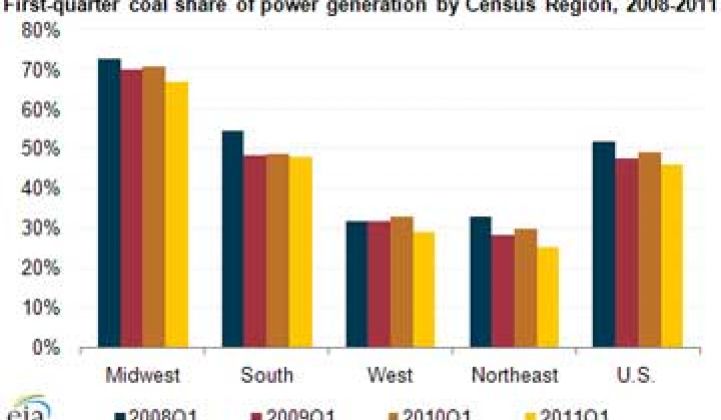The percentage of electricity generated by coal in the first quarter of this year was the lowest it has been in more than 30 years.
New data from the U.S. Energy Information Administration showed that coal generated about 440 terawatt hours, 26.5 TWh less than the same quarter of 2010. Overall generation of electricity increased slightly in the same time period.
Don’t be confused by the figures, however. Coal is still king, making up 46 percent of total generation -- although that’s 3 percent lower than the same period last year.
There are various reasons for the decrease in coal. One reason is that as coal prices have steadily risen in many areas of the U.S., natural gas has stayed relatively cheap. Even the coal-rich Midwest is using less of its prized resource, although it still makes up nearly 70 percent of the electricity generation in the region.
The slight downturn in coal comes just after American Electric Power closed its carbon capture and storage test facility, one of the largest demonstration projects in the world for CCS. Without carbon legislation, utilities don’t want to invest in CCS, yet other regulations are still forcing at least the dirtiest of coal plants out of commission.
Coal plants are also under increased pressure to be taken offline in favor of (less dirty) natural gas plants. It is estimated that up to 20 percent of coal-fired power plants will be taken off-line this decade due to EPA regulations that call for a reduction in cross-state pollution of sulfur dioxide and nitrogen dioxide.
Renewables can’t claim a win over coal by any stretch of the imagination, but generation from wind was up 25 percent from April 2010. Although California, Texas and Illinois have had the largest gains, the EIA said the gains were widespread across the U.S. As aggressive renewable portfolio standards are implemented in the next decade, renewables (and not just hydro) will continue to increase.
The decrease in coal generation might be a window into the future, but that future is still far down the road. The EIA also noted that the second quarter of this year had coal increase again, mostly due to increased output to make up form nuclear plants that were offline.



